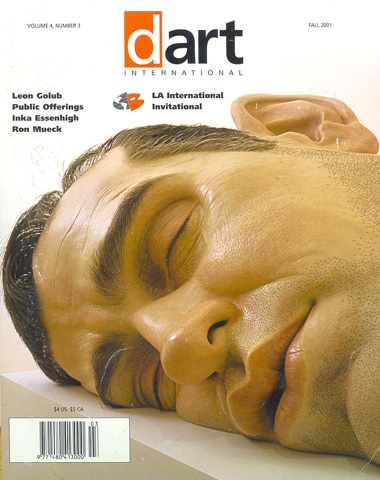
Leon Golub's Gigantomachy
Paintings 1950-2000 at Brooklyn Museum of Art
by Jeanne C. Wilkinson
As ever, there is nothing ingratiating in Leon Golub's paintings. But we are drawn in anyway-his awkward, brutish thugs painted in awkward, brutish strokes muscle their way into our vision. Some of the images have scenes common with certain Christian paintings of torture, brutality, and martyrdom. On vast unstretched canvasses, images of beasts both human and otherwise hang in the foreground like floaty Byzantine saints. But the victims in Golub's paintings are anonymous and will ever remain so, and for the perpsí unholy casualness robs their acts of any possible ritual meaning.
Also, saints never force their way into the viewers' space like Golub's figures do. In his paintings of terrorists and mercenaries from the '80s, the foreground is tightly wedged between our vision and gritty walls and other ambiguous planes. His characters are squeezed off the canvas; their claustrophobic arena aggressively expanded to include, for a disturbing moment, our own world. In this suffocating place unspeakable acts are enjoyed by nameless corrupted everymen in everyday corners of our industrialized, de-natured world. The viewer in front of the painting is dwarfed by the horrific action, but at the same time part of the circle of thugs that surround the victim. This is particularly true in the Interrogation paintings-one of a naked woman who cringes, unable to protect herself, on the ground, and one of a naked man hanging upside down-helpless between two harassing torturers.
Golub is a skilled artist who seems heavily invested in not appearing so. It's as if he is straining to keep his obvious love for painting and its formal challenges and fascinations out of the picture, perhaps in an attempt to better make his point about the world and its hideous injustices- as if he fears that revealing this love of paint would self-indulgently compromise his harsh message.
Goya, with whom Golub is often compared, had a style that was straightforward, direct-his simple, deft lines delivered the message and were not the message itself. Golub's painting style, on the other hand, is expressionistic to an extreme degree. His paint is scratched across the rough surface of the canvas like a fingernail over a blackboard. His tortured forms are scraped raw. A kind of gray pall suffuses the colors and chokes the imagery, rendering it airless, futureless, frozen in time. This is rough painting. Maybe too rough for its own good. Golub gets his message across using compositional and painterly strategies, or maybe
anti-painterly strategies, and while in many cases his crudities are powerful tools, at other times they come uncomfortably close to overkill.
One of the strongest paintings in the exhibition is Horsing Around III (1983) showing three figures drinking and posing for the viewer-big people whose sexuality is both on display and ambiguous-are they women or cross-dressing men? The shimmery pastels of this painting both contrast with and accentuate the underlying threat of these people. Their united front, their gleaming, glowing presences, their smirking lips, their empty eyes lead us to think about their trangressions upon the world when they aren't 'horsing around.' The careful drawing of the figures, naive but dead-on accurate, projects their powerful yet simplistic view of the world, where their pleasure is the measure of all things.
This work is all the stronger for the artist's forthright use of color and sinuous line. The figures stun us in their blatant crudity and eroticism. The power of their brute bodies overwhelms and lures us into their world of heavy, primal pleasures and utter abandonment to a realm of seductive depravity. In this painting, the artist seems to be collaborating with the paint, moving it in and out of the forms where it creates an eery, powerful life within them.
In other works, the figures seem to struggle and scratch on the edge of oblivion. While this stylistic choice may be a visual metaphor for life's treacheries and disappointments, the painting itself disappoints to the point where the message is undermined. Golub, struggling for many years in an artworld that scorned figurative painting, developed a highly individual style that claimed worldwide attention. But in his recent work he seems to back away from his own power of expression-the compositions are disjointed, the spacial tensions weakened, and the painting ever more crude and uncrafted. The work looks like a lot of not very interesting painting that's around now.
As if to replace what is missing, there are now words added to the paintings. In Prometheus II (1998), the words "Fuck! I didn't expect this!" are spelled out above the disjointed, anguished head, bizarrely trivializing the drama, rendering it bathetic, silly. Words are all over Golub's paintings now, like unnecessary, irrelevant chatter, noisy bits that obliterate the silent screams that otherwise well up in the mind when observing his work. Some phrases seem intended to be humorous, like "getting old sucks" on a sign held by an aging lioness, who, in any natural setting, would never live to grow old. But in too many cases the words seem to deliberately undermine the strength of the visual message.
There is a contradiction inherent in Golub's work that is puzzling. Some of it is so close to being simply great painting, but, somehow, paradoxically, the artist pulls his punches.
|